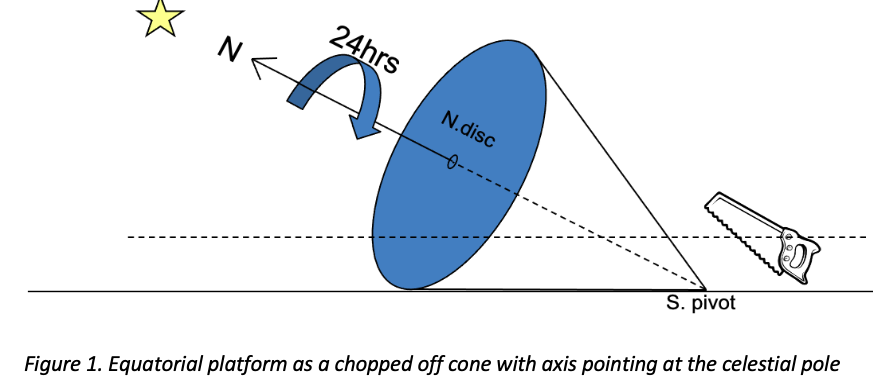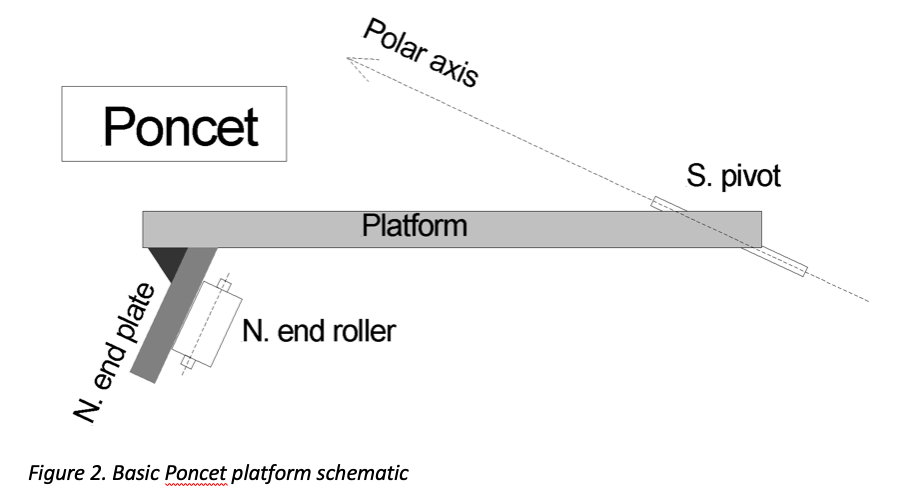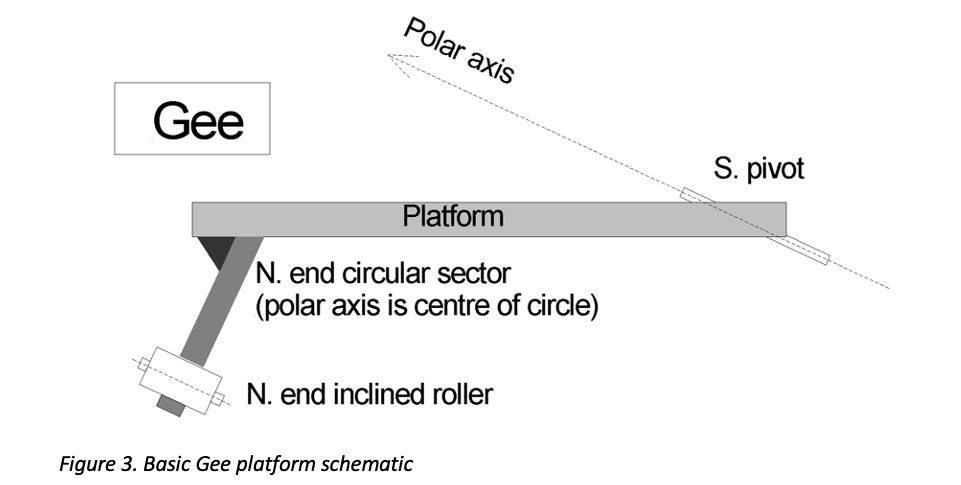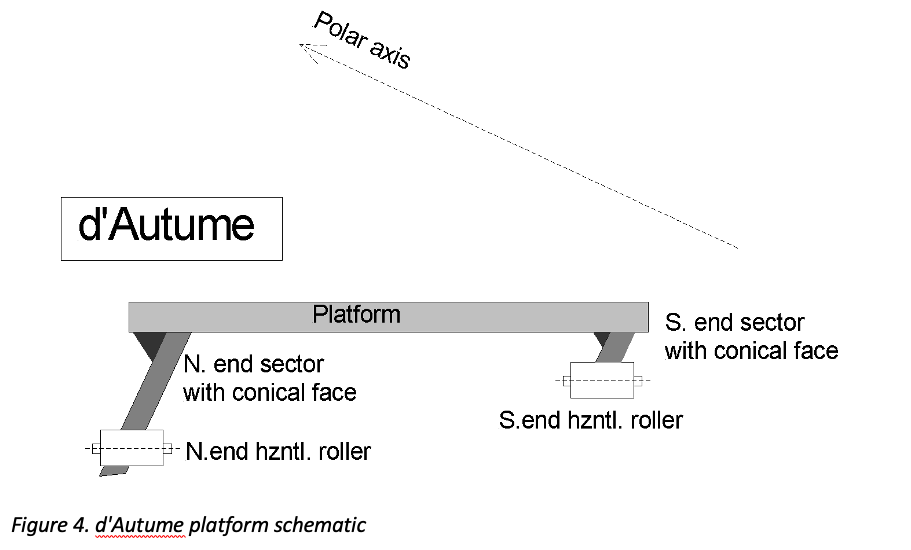Equatorial Platforms Part One
Originally published as Equatorial Platforms Pt. 1, BAA Journal Vol. 132, No 1 Feb. 2022, E&T section, p21.
By Martin Lewis
This is the first of three articles about equatorial platforms, attempting to demystify these odd-looking mounts and hoping to extend their popularity amongst imagers and observers. Such mounts are particularly appealing to owners of undriven alt/az scopes such as Dobsonian reflectors; they allow the user to have the best of both worlds – smooth manual location based on a human up/down and left/right movement frame, combined with equatorial tracking with no field rotation, once the object is found.
This first article will concentrate on the principles of equatorial platforms and look at the three main designs. The second part will spend time looking in detail at variants suited for heavier telescopes, whilst the third will look at drive systems and platform alignment. Hopefully I’ll inspire a reader or two to have a go at building a platform themselves.
At its simplest, an equatorial platform, when properly made and polar aligned, will provide a low profile and very stable table which will allow anything placed on it to follow the rotation of the heavens for a limited period – typically 60mins. In the middle of the tracking period the table will be horizontal but at the beginning and end it will be tipped up by several degrees. A reasonable limit on the tracking period prevents anything sitting on the platform from over-balancing.
An equatorial platform enables you to do short exposure imaging at high magnification, such as for planetary, lunar and solar imaging, lower power visual observing over much longer periods, and deep sky imaging at low power with exposures of few seconds. You can even place a tripod on the platform to provide tracking for wide angle DSLR images of the skies lasting a few minutes.
Unlike standard telescope equatorial mounts, the polar axis on a modern equatorial platform is virtual and mostly lies outside of the physical parts of the mount. It is this aspect of the design that tends to make them hard to fully understand.
To best visualise the essence of an equatorial platform, imagine a large cone placed on the ground with the axis pointing at the celestial pole. Imagine too, it is arranged to rotate about its conical axis once every 24hrs. If the cone is cut off several inches above the ground and the dish-shape filled in, you then have a flat platform which will allow anything placed on it to track the rotating sky (Figure 1).

Several different designs of equatorial platform exist; the differences depending mainly on the various methods of mechanical constraint used to keep the axis pointing at the pole.
Adrian Poncet conceived of the first equatorial platform in 1977. The Poncet mount used a real pivot at the apex of the cone at the south end and sliding or rolling contacts against the inside face of the disc at the north end (Figure 2). It was simple to make and the north end disc did not even need to be a circular disc – just a plane perpendicular to the polar axis. The mount was only really suitable for low loads at high latitudes, however. At low latitudes the forces were unfavourable as the N.disc really needed edge support to stop the polar axis drooping.

Alan Gee designed a variant with the N.disc explicitly circular and rollers supporting the disc edge – these inclined rollers were aligned parallel with the polar axis instead of perpendicular to it (Figure 3). The Gee design worked much better at lower altitudes and was able to take higher loads but at higher altitudes the rollers became more vertical and forces became unfavourable again. A variant of the Gee uses additional rollers bearing against the inside face of the N.disc to efficiently cope with the load considerations at higher altitudes. This variant really is a mix of Gee and Poncet and a beautifully designed modern commercial interpretation of this design can be seen at: https://www.triangulumastro.com.

The Gee design is conceptually simple with short sections of the circular N.disc driven from the rim. There is enough rim to allow for an hour or so of driving and the rest of the full disc is dispensed with. There can be one sector spanning the rollers or two shorter sectors each representing about 15° to 20° of the full circle.
To get away from the mechanical issues at high or low latitudes and to maximise the platform stability, Georges d’Autume suggested in 1988 making the two north roller bearings horizontal (Figure 4). This supports the moveable part of the platform in a much more mechanically favourable manner. Another advantage of this arrangement is that it maximises the friction between the roller and edge of the drive sector meaning it can be driven more easily by frictional contact from one of the rollers. As well as making the rollers horizontal, d’Autume did away with the pivot at the south end and used a circular sector at this end too. The advantage of this is that this allows one to elevate the polar axis above the platform. One can then arrange things to that the centre of gravity of the telescope is on the polar axis, reducing the torque on the rollers and reducing the likelihood of slippage if driven from one of those rollers.

The d’Autume platform is more conceptually more complex than the Gee and harder to fabricate. This because having horizontal rollers then requires the edge faces of the sectors to be conical in form rather than cylindrical as they are for the Gee.
The mechanically strongest design of all is a variant on the basic d’Autume, the so-called VNS (vertical North sector) variant. This again has horizontal rollers but the sectors at the north end, instead of being inclined, are vertically set – again with their contact faces being conical in shape instead of cylindrical. You can see superb commercial platforms based on the VNS design at: http://www.equatorialplatforms.com
Part Two of this article will talk more about variants based on Gee, d’Autume and VNS, comparing three modern designs suitable for construction by amateurs and able to support larger telescopes.
https://britastro.org/wp-content/uploads/2022/11/Equatorial-Platforms-Part-1-Fig-1.png
https://britastro.org/wp-content/uploads/2022/11/Equatorial-Platforms-Part-1-Fig-2-.png
https://britastro.org/wp-content/uploads/2022/11/Equatorial-Platforms-Part-1-Fig-3.png
https://britastro.org/wp-content/uploads/2022/11/Equatorial-Platforms-Part-1-Fig-4-.png
| The British Astronomical Association supports amateur astronomers around the UK and the rest of the world. Find out more about the BAA or join us. |
